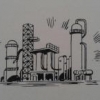Dear Sir,
For a Refinery Diesel, we always say that Diesel Fuel should have Recovery at 360 DEg C i.e E360 as minimum 95 percent Volume Distilled. Why we want to keep minimum and maximum limits on E360 property of Diesel .What will happen if we exceed these limits on minimum and maximum sides ? Can you please explain ?
Thanks
Regards

 FB
FB












